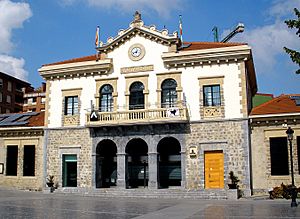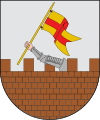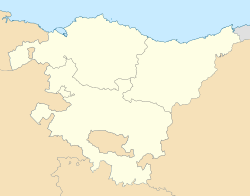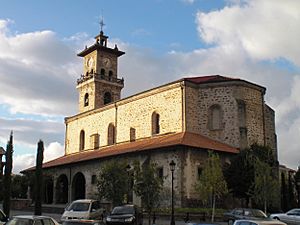Amurrio facts for kids
Quick facts for kids
Amurrio
|
||
|---|---|---|

Town hall of Amurrio
|
||
|
||
| Country | ||
| Autonomous community | ||
| Province | Alava | |
| Comarca | Aiaraldea | |
| Founded | 1919 | |
| Area | ||
| • Total | 96.36 km2 (37.20 sq mi) | |
| Elevation | 219 m (719 ft) | |
| Population
(2018)
|
||
| • Total | 10,286 | |
| • Density | 106.746/km2 (276.470/sq mi) | |
| Time zone | UTC+1 (CET) | |
| • Summer (DST) | UTC+2 (CEST) | |
| Postal code |
01470
|
|
| Official language(s) | Basque Spanish |
|
Amurrio is a lively town and municipality in the northwest of Álava, a province in the Basque Country, northern Spain. It's home to over 10,000 people and is located between the cities of Vitoria-Gasteiz (about 41 km away) and Bilbao (about 31 km away).
Contents
- Exploring Amurrio: A Spanish Town
- Amurrio's Past: A Brief History
- Amurrio's Economy: How People Make a Living
- Amurrio's Population: How It Has Grown
- Amurrio's Connections: Twin Town
- Amurrio's Culture: Language, Festivals, and Museums
- Sports and Outdoor Activities in Amurrio
- Exploring Nature: Routes Around Amurrio
- Famous People from Amurrio
- Images for kids
- See also
Exploring Amurrio: A Spanish Town
Amurrio is located in a special spot, bordering several other towns.
- To the North: Ayala and Orozko (in Biscay).
- To the South: Orduña (also in Biscay).
- To the East: Zuia.
- To the West: Ayala.
Villages within Amurrio
The municipality of Amurrio includes 10 smaller villages:
- Aloria
- Amurrio (this is the main town)
- Artomaña
- Baranbio
- Delika
- Larrinbe
- Lekamaña
- Lezama
- Onsoño
- Saratxo
- Tertanga
Amurrio's Past: A Brief History
Amurrio first appeared in written records in 1095. It gained its own local government in 1842, after being part of Ayala. The town became fully independent in 1919. This shows Amurrio has a long history, but its buildings and strong industries also show it's a place full of new energy.
Even as industries grew, Amurrio remained an important farming area. In the 1950s, small workshops made things like gold and silver items, and even liqueurs. Companies making railway parts and valves also started up. These businesses helped the local farming economy.
A big change happened when large steel companies moved in. They promised many jobs, attracting people from other places. This made Amurrio's population double by 1975. In 1976, nine more towns joined Amurrio, creating the administrative area we see today.
Amurrio's Economy: How People Make a Living
Amurrio's economy mostly relies on industry, though services are also important. Over 60% of the people in Amurrio work in factories and workshops.
Historically, making steel and tubes has been Amurrio's most famous industry. Even with changes in the 21st century, many jobs were created. Today, two of the biggest steel tube makers in the Basque Country and Europe, Tubacex and Tubos Reunidos, are located between Amurrio and Llodio.
The industrial areas of Aldaiturriaga and Saratxo are perfect for businesses. They are close to railways and roads, offering good land and facilities.
Major Factories in Amurrio
Here are some of the factories in Amurrio with more than 50 employees:
- Aceralava Acería de Álava: 150 employees.
- Amurrio Ferrocarril y Equipos: 175 employees.
- Industria Auxiliar Alavesa (INAUXA): 140 employees.
- Kime: 110 employees.
- Lázaro Ituarte Internacional: 50 employees.
- Möllertech: 330 employees.
- Tubacex Tuberías Inoxidables (TTI) : 160 employees.
- Tubos Reunidos: 940 employees.
Because of the many steel manufacturing factories, Amurrio has also developed a network of smaller steel-related businesses:
- Talleres F.Larrinaga: Makes valves and gears.
- Castinox: Produces valves, stainless steel, and other industrial parts, including metal casting.
Other Important Industries
The wood manufacturing and construction sectors are also notable:
- Etxeguren: Handles industrial projects like maintenance and machinery installation.
- Plaza Amurrio: Supplies materials and furniture for construction.
Even though agriculture is not the main industry, you can find important shops selling local products:
- Industrias Cárnicas Burutxaga: A meat processing company.
- Lur Denok: Sells organic food.
Amurrio's Population: How It Has Grown
During the 1960s and 1970s, Amurrio's population grew a lot. This was partly because of the growth of industries in nearby Biscay, as Amurrio is close to Bilbao.
From the 1980s onwards, due to an economic recession, the population stayed about the same. However, in 2008, the town started growing again and reached over 10,000 inhabitants.
| Population of Amurrio |
|
EasyTimeline 1.90
|
Source: www.ine.es
Amurrio's Connections: Twin Town
Amurrio has a special connection with one other place:
 Western Sahara, Agounit.
Western Sahara, Agounit.
Amurrio's Culture: Language, Festivals, and Museums
Amurrio has a rich culture, especially when it comes to the Basque language and local traditions.
Basque Language and Culture
The Basque dialect spoken in Amurrio is a type of the Western dialect. About a quarter of the people living in Amurrio speak Basque. To encourage its use, the town hall organizes campaigns and learning programs every year. One example is Euskaraz Bizi eguna, a day where everyone is invited to join in activities and talks in Basque.
There is also an ikastola (a Basque-language school) called "Aresketa" and a bertso-eskola (a school for traditional Basque improvised poetry). Both offer lessons in Basque. Amurrio has also hosted Araba Euskaraz (a festival to support Basque schools) several times: in 1986, 1996, 2005, and 2013.
Groups that promote the Basque language include Belaiki euskara elkartea, Aspaltza euskara elkartea, Aiaraldea, and Aiaraldeko Euskalgintza Kontseilua.
Fun Festivals in Amurrio
Amurrio celebrates many festivals throughout the year:
- From August 11 to 17: Main town festivals honoring Assumption of Mary and Saint Roch.
- August 15: Blessed Virgin Mary day.
- August 16: Saint Roch day.
- Artzain eguna (Shepherd's Day): Third Sunday of September. This day features activities about shepherding, like cheese competitions, sheep meat tasting, and shearing demonstrations.
- Mikoturismo eguna (Mushroom Tourism Day): In November. Activities include talks about mushrooms, special menus with mushrooms, and a pintxo (small snack) competition.
- January 17: Anthony the Great (San Anton) day.
- October 28: Simon the Zealot and Jude the Apostle (San Simon and San Judas) day.
- April 28: Festivals honoring San Prudencio, the patron saint of Álava.
- May 9: Las Entradillas dance.
- Txakolin eguna (Txakoli Day): In May, the Sunday after Isidore the Laborer's day. This celebrates the local txakoli wine, which has a special "origin denomination" called Txakoli de Álava.
Museums to Visit
Amurrio has interesting museums:
Aresketamendi Outdoor Museum
This outdoor museum is on the edge of Amurrio, near Zaraobe, an old meeting place. It covers a large area of 22,600 square meters. It focuses on renewable energies like wind, water, sun, and biomass. It teaches about sustainable energy practices with 26 interactive displays for all ages.
Museum of Liqueur
This was the first museum of its kind in Euskadi (the Basque Country). It tells the story of Manuel Acha's distillery, founded in 1831. You can see old barrels from the 19th and 20th centuries, accounting books, and old advertisements. It also features items from the Karpy cycling club from the 1960s and 1970s. The museum has three rooms covering about 250 square meters.
Txakolineria (Txakoli Winery)
This is the largest producer of txakoli wine in Álava. Visitors can tour the txakolineria and then enjoy a tasting in the txoko, a local gathering place where friends often meet.
Important Buildings and Monuments
In 1905, Amurrio already had a small Romanesque "monastery" on a hill near the main road. Over time, houses were built around it, including the Palacio de Cejudo mansion. On another hill, near where roads meet, the San Antón chapel and the Ugarte Tower-House were built. This is why many old large houses and churches are found along the roads, not just in town squares.
Church of Santa María
This church still has a pointed arch and supports from its old Romanesque church, dating back to the mid or late 13th century. However, most of the building is in the Renaissance style, from the mid-16th century. The altarpiece is beautifully designed, with only its central part covered in gold. The Stations of the Cross paintings were done by Juan de Aranoa.
San Antón Chapel
This chapel was an important meeting place for old councils, where people would take oaths. Every year on January 17, judges and other officials were appointed here. Old records also say that the Hospital of San Antón was next to it, offering shelter to travelers on the St James pilgrimage route. The statue of St Anthony in the chapel was made by Mauricio Valdivielso. Today, a market is held at San Antón chapel every Friday.
Urrutia Tower-House (Palacio de Cejudo)
Also known as the Palacio de Cejudo, named after the family who lived there. It's next to the church and the old main road that connected Castile (historical region) with ports on the Bay of Biscay. This beautiful 16th-century building is known for its stone work and simple design.
Ugarte Tower-House
This tower-house was built in 1728 by Manuel de Ugarte y Orúe, a Knight of the Order of Santiago. It cost over six thousand silver pesos. Since 1983, it has served as the town's cultural centre.
Palacio de Larrako, in Lezama
This mansion is located near where another road branches off from the old road connecting Vitoria-Gasteiz and Balmaseda, between Lezama and Berganza. Captain Juan de Ugarte ordered its construction in the 1640s. The building is well-preserved and gives a good idea of how wealthy families lived in large houses back then.
GUK Sculpture
The "GUK" sculpture, which means "we" in English, was added to Amurrio in 2000. It is made of steel and has hundreds of names written on it. Every year, a special event is held to honor citizens who have helped improve the town and community life.
Sports and Outdoor Activities in Amurrio
The most popular sports in Amurrio are football, basketball, cycling, and traditional Basque sports and dances. People also enjoy skiing, mountain climbing, and mountain running. Most sports activities take place at the sports center or "Refor," a large sports complex with a gym, track, two football fields, a rugby field, a tennis court, and a basketball court.
Football
Amurrio has a football club called Amurrio Club, founded in 1949. They play in Tercera División.
Basketball
The basketball team of Amurrio is called Zaraobe ST, founded in 1985 by Marcos Maroto.
Cycling
There is also a cycling club in Amurrio, the Club Ciclista Amurrio.
Basque Traditional Sports and Dances
Basque pelota (a traditional ball game) and traditional dances are also very popular in Amurrio. The group Aiara Dantza Taldea is responsible for teaching these dances.
Exploring Nature: Routes Around Amurrio
The gentle hills around Amurrio, like the nearby Sierra Salvada and the Altube forest, are great for walking and exploring. You can find old shepherds' trails, trade routes, and historical roads throughout these valleys, forests, and mountains. Here are a few popular routes:
Monte Santiago and Nervión Waterfall
You can find this beautiful spot by following the old main road from Bilbao to Pancorbo, in the province of Burgos. Just past Orduña, there's a steep mountain pass that climbs to 900 meters. A little further, a sandy path leads into Monte Santiago, a protected natural area with many beech trees. Here, you'll find the remains of an old wolves' den and a viewpoint overlooking the Nervión waterfall, which drops almost 300 meters. The name Monte Santiago comes from an old monastery dedicated to Santiago Apóstol (St James) that stood here, first mentioned in 1075.
Ayala Route
If you take the Balmaseda road from Amurrio, you'll soon reach Zaraobe. This high area was where the village and district councils of the Tierra de Ayala used to meet until 1841. To your left, you'll see the impressive Sierra Salvada, with peaks over 1,000 meters high. The road winds past hills where sheep and cattle graze, and you'll see many traditional farmhouses.
A few kilometers from Amurrio is Respaldiza, the main village of the Ayala municipality. Its church portal dates from the late 12th century, contrasting with the 18th-century town hall, but they form a unique architectural pair.
After Respaldiza, you'll reach Quejana, the ancestral home of Chancellor Pedro López de Ayala, a famous writer. Here, you can admire a well-preserved tower with its chapel dedicated to the Virgen del Cabello. The chapel contains the alabaster tombs of Don Pedro and his wife Leonor de Guzmán. Today, a Dominican convent is there, with a small museum about the people of Ayala and their history.
Continuing past Quejana, you can reach Artziniega, about 12 kilometers from Amurrio. This town received its charter from Alfonso X in 1272. It features remains of old walls, narrow streets with unique buildings, and well-preserved fortress towers.
Sierra Salvada Mountains
For mountain lovers, Amurrio is a great starting point to explore the Sierra Salvada. This mountain range, with peaks like Tologorri, Ungino, and Eskutxi, reaches over a thousand meters high and forms a natural border with Burgos. There are many ways to reach the summits. The most famous peak is Tologorri, where the Amurrio mountain-climbing group Mendiko Lagunak maintains a refuge. In about an hour and a half, you can cross the ridge and enjoy amazing views of the Tierra de Ayala, the mountains of Biscay, northern Burgos, and Cantabria.
Famous People from Amurrio
Many notable individuals have come from Amurrio:
- Jesús de Galíndez: A writer, lawyer, professor, and politician.
- Inma Shara: A well-known orchestral conductor.
- Iñaki Bea Jauregi: A retired football player.
- Mikel Álvaro Salazar: A footballer who played for Dinamo Tbilisi.
- Per Bat, Peregrino Bat.
- Izaskun Bengoa: A former road cyclist, born in 1975.
- Jesus Etxebarria: A sculptor (1916-2009).
- Federico Barrenengoa: A professor, philosopher, and respected Basque scholar (1916-2005).
- Santiago Abascal Escuza: A politician (1949–2017).
- Xabier Aspuru: A professor and politician, born in 1951.
- Zigor Urrutia Revuelta: A photographer and designer from Bilbao, born in 1971.
- Eli Pinedo: A professional handball player, born in 1981.
Images for kids
See also
 In Spanish: Amurrio para niños
In Spanish: Amurrio para niños






